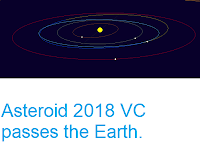Asteroid 2018 VX1 passed by the Earth at a distance of about 381 300
km (0.99 times the average distance between the Earth and the Moon, or
0.25% of the distance between the Earth and the Sun), at about 6.20 pm
GMT on Saturday 10 November 2018. There was no danger of
the asteroid hitting us, though were it to do so it would not have
presented a significant threat. 2018 VX1 has an estimated
equivalent
diameter of 5-19 m (i.e. it is estimated that a spherical object
with
the same volume would be 5-19 m in diameter), and an object of this
size
would be expected to explode in
an airburst (an explosion caused by superheating from friction with the
Earth's atmosphere, which is greater than that caused by simply
falling, due to the orbital momentum of the asteroid) in the atmosphere
between 40 and 24 km above the ground, with only fragmentary material
reaching the Earth's surface.
120 second image of 2018 VX1 taken with the Elena Planetwave 17" Telescope at Ceccano in Italy on 10 November 2018. The asteroid is the small point at the centre of the image, the longer lines are stars, their elongation being caused by the telescope tracking the asteroid over the length of the exposure. Gianluca Masi/Virtual Telescope.
2018 VX1 was discovered on 4 November 2018 (six days before its closest approach to the Earth) by the University of Arizona's Mt. Lemmon Survey at the Steward Observatory on Mount Lemmon in the Catalina Mountains north of Tucson. The designation 2018 VX1 implies that the asteroid was the 48th object (object X1) discovered in the first half of November 2018 (period 2018 V).
The calculated orbit of 2018 VX1. Minor Planet Center.
2018 VX1
has an 583 day orbital period and an eccentric orbit
tilted at an angle of 2.79° to the plane of the Solar System, which
takes it from 0.94 AU from the Sun (i.e. 94% of he average distance at
which the Earth orbits the Sun) to 1.79 AU from the Sun (i.e. 179% of
the
average distance at which the Earth orbits the Sun). It is therefore
classed as an
Apollo Group Asteroid (an asteroid that is on average further from the
Sun than the Earth, but which does get closer). As such the asteroid has
occasional close encounters with the planet Earth, which it last came
close to in December 2010, and is expected to do so again in October 2026. The asteroid also has occasional close encounters with the planet Mars, which it last came close to in April 1986 and is next predicted to pass in December 2026.
See also...
Follow Sciency Thoughts on Facebook.








